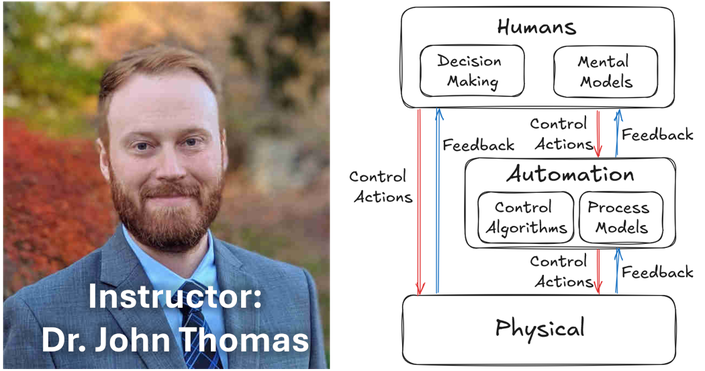Welcome to the STAMP Institute
Where Safety and Innovation Meet
The STAMP Institute is dedicated to improving how system safety is taught and practiced across industries. Built on cutting-edge methods like STPA (System-Theoretic Process Analysis) and CAST (Causal Analysis based on STAMP), we empower engineers, safety professionals, and managers with the skills and tools needed to design safer, more effective systems with today’s increasingly complex technologies.
What You Will Learn
Our courses provide comprehensive training on the latest safety approaches and principles, with a focus on:
- System Safety Engineering: Develop a deep understanding of the core principles that underlie modern system safety, especially those that are often misunderstood. Learn how to apply these principles to prevent accidents and manage risks across industries.
- System-Theoretic Process Analysis (STPA): Learn the principles and steps of STPA, an advanced hazard analysis method designed for modern, complex systems. Gain hands-on experience applying STPA to real-world scenarios across industries like aerospace, automotive, healthcare, and energy.
- Limitations and Pitfalls: Many classes focus on what to do and how to do it, but they overlook the reasons why and the gaps and limitations that must be addressed. Our classes use real-world examples to show common mistakes and explain the limitations of each method. In addition to best practices, you will learn what NOT to do when developing, analyzing, and deploying safety-critical systems.
Why Choose STAMP Institute?
- Expert-Led Instruction: Our courses are designed and taught by world-renowned experts in system safety. You’ll learn directly from the pioneers in the field.
- Cutting-Edge Techniques: We teach the most advanced, innovative safety methods that are rapidly gaining recognition across industries. STPA has already been adopted by major players in aerospace, automotive, healthcare, nuclear, and energy sectors.
- Practical Application: Our courses go beyond theory, providing you with real-world applications, case studies, and hands-on practice so you can immediately implement what you learn in your own work.
- Stay Ahead of the Curve: In today’s fast-paced industries, safety standards are evolving. By mastering modern safety techniques like STPA , you'll be at the forefront of ensuring safety in increasingly complex systems.
Who Should Enroll?
- Engineers, safety professionals, and system designers in aerospace, automotive, healthcare, energy, and other industries looking to expand their skills.
- Managers and decision-makers who want to implement cutting-edge safety methodologies in their organizations.
Invest in Your Future
At the STAMP Institute, you’ll master practical, actionable skills that can transform your career and help protect lives. Enroll to join a growing community of professionals shaping the future of system safety.
"Using traditional techniques based on probability, we can 'what if' everything into oblivion. Using STPA will allow concepts and architectures that will lead to the next big leap in aviation automation and safety."
- FAA Participant


Aviation
"The STPA method ... forces thinking of the overall problem, not just the numbers."
- Civil Aviation Regulator

Defense
"As a new System Security Engineer, this has given me a good foundation about how to approach System Engineering"
- Defense Contractor Participant

Digital Engineering
We were able to provide more comprehensive coverage of potential vulnerabilities than traditional methods, with reductions in cost and schedule.
- EPRI Hazard Analysis Demonstration

Automotive
"STPA can serve as a suitable technique because it does not necessitate that there be a failure in order for a hazard to occur."
- SOTIF Standard ISO/PAS 21448 (Safety of the Intended Functionality)

Nuclear Utility
"This is mind-blowing process, much better than what we do now.”
- Digital I&C Engineer

Electric Vehicles
We applied STPA alongside Fault Tree Analysis. STPA took three times less effort and identified critical cases overlooked in the fault tree.
- Valeo

Hi, I’m John Thomas
At MIT, I teach classes and conduct research in system safety, automation, and human factors. I previously worked as an engineer in automotive, defense, and aerospace sectors, where I gained hands-on, practical experience that now informs my teaching and research. I believe in providing practical solutions and testing new ideas on real-world projects rather than focusing solely on theoretical concepts.
Most of my work involves collaborating with leading companies and regulatory bodies to identify and address gaps in system engineering and safety practices. My research focuses on understanding engineering mistakes and human errors that lead to accidents and losses, with the goal of closing gaps in modern engineering and safety management practices. As a pioneer in system safety, particularly STPA (System-Theoretic Process Analysis), I’ve been recognized for shaping the development of key safety standards in aviation, automotive, and nuclear industries.
While I often provide tailored education for major companies and regulatory bodies, I’ve increasingly received requests from individuals seeking more flexible, cost-effective options. I’ve decided to adapt the teaching materials I use at MIT into professional online classes, making the same high-quality education available to practitioners.




